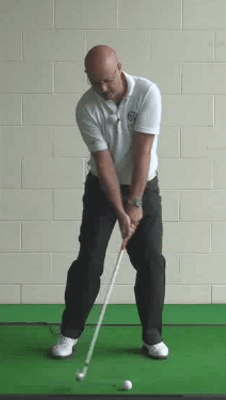You're Correct!
 We are all liable to hit shots fat and thin in a round of golf. Some do it more severely or regularly than others but these shots whether 200 yards out or chipping on to the green can lead to poor scores.
We are all liable to hit shots fat and thin in a round of golf. Some do it more severely or regularly than others but these shots whether 200 yards out or chipping on to the green can lead to poor scores.
A great ball striker will catch the ball first followed by a little bit of turf, a divot. The divot would be relatively shallow and cleanly taken. To achieve this and one primary aspect of the impact position should be that your hands are ahead of the ball at the impact position. This encourages an angle of attack steep enough to correctly compress the ball for optimum distance and trajectory.
Be careful not to get your hands too far ahead but the most common fault amongst amateurs would be the hands being behind the ball at impact. This is called an early release and is caused by the premature and extensive hinging of the wrists during the back swing which can cause the club to unhinge into the ball too early and impact the ground before the ball or miss the ground and catch the ball thin.
Weight transference should also be looked at when trying to solve this problem. If the weight is falling back to the right foot during the down swing, plus the hands releasing too early into the ball can promote both fat and thin strikes.
A great drill is to put the golf ball on a high tee, similar to the height you would use a driver and try to hit the ball as low as you can. If you release the club too early the ball will go extremely high. Once you start to get a good trajectory then take the tee away and hit balls with the same train of thought and watch your ball flight strengthen and your strikes become better.
Sorry Try Again! - See Explanation Below
When you are catching the ball fat or thin or if you are even worried about catching it this way, the worst possible thing you can do is try to lift the ball into the air yourself. Golf is a game of opposites; so for example, if you hit down on the ball then the ball will go up. This is a thought process you need to keep with you for all aspects of golf.
The more you try and lift the ball into the air, the less consistency your strikes will have because this promotes the early release of the wrists and the negative weight shift during the down swing. If the wrists release early and the weight shifts to the right side during the down swing then the club will instantly shallow its angle into the ball and catch the ball thin. Also, if the weight shift is too extensive towards the left side and the wrists release early, the angle of attack will steepen causing fat shots. These are two key fundamentals to watch to help prevent trying to lift the ball.
Sorry Try Again! - See Explanation Below
Keeping your weight on the left side during the swing can help many golfers with their strikes depending on their flexibility hindrances. However, more often than not it can cause the club to approach from an extremely steep angle of attack and chop into the ball. Also too much weight on the side can cause irregular swing paths, potentially leading to sliced shots.
Sorry Try Again! - See Explanation Below
Ball position can have an extremely significant impact on ball striking consistency, however, keeping the ball positioned in the centre of the stance with every club is not the answer due to all the clubs being different lengths as the angle of attack constantly changes.
The golf ball positioned centrally with an 8 iron thru to a pitching wedge will be a good thing, depending on weight transference and wrist angle at impact but once the clubs lengthen up to 4 iron and drivers, for example, the angle of attack will steepen promoting fat and poor directional shots.







